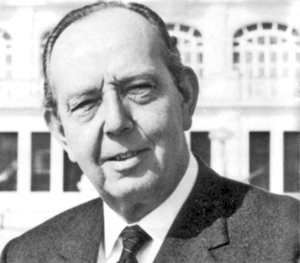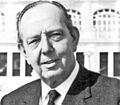Stanley Hooker facts for kids
Quick facts for kids
Stanley Hooker
|
|
|---|---|

Sir Stanley Hooker
|
|
| Born |
Stanley George Hooker
30 September 1907 Sheerness, Kent, England
|
| Died | May 24, 1984 (aged 76) |
| Education | Borden Grammar School, Imperial College, Brasenose College |
| Occupation | Engineer |
| Spouse(s) |
Margaret Bradbury
(m. 1937; div. 1950)Kate Maria Pope
(m. 1950) |
| Parent(s) | William Henry Hooker Ellen Mary Russell |
| Engineering career | |
| Institutions | Rolls-Royce Limited Bristol Aeroplane Company |
| Projects | Rolls-Royce Derwent, Rolls-Royce Nene, Bristol Olympus, Bristol Orpheus, Bristol Siddeley Pegasus |
| Significant advance | Aircraft engines |
| Awards | Wilhelm Exner Medal (1982). |
Sir Stanley George Hooker (born September 30, 1907 – died May 24, 1984) was a brilliant mathematician and jet engine engineer from England. He helped create some of the first jet engines.
He first worked at Rolls-Royce, where he designed early jet engines like the Welland and Derwent. Later, at Bristol Aero Engines, he improved engines such as the Proteus turboprop and the Olympus turbojet. He also designed the famous Pegasus engine, which allowed the Hawker Siddeley Harrier jet to take off and land vertically.
Contents
Early Life and Education
Stanley George Hooker was born in Sheerness, England. His father was a farm worker. Stanley went to Borden Grammar School. He was very smart and won a scholarship to study mathematics at Imperial College London.
He became very interested in how air moves around objects, which is called aerodynamics. In 1928, he won a special scholarship for aeronautics. He then moved to Brasenose College, Oxford and earned his PhD in aerodynamics in 1935.
Working at Rolls-Royce
In 1937, Stanley Hooker applied for a job at Rolls-Royce. He started working there in January 1938. He was allowed to study anything he found interesting. Soon, he began working on superchargers, which are parts that help aircraft engines get more power.
He found ways to make the superchargers on the Merlin engine much better. His ideas increased the engine's power by about 30%. These improvements were used in famous planes like the Spitfire Mk V and Spitfire Mk IX. The Merlin 61 engine, with Hooker's improved supercharger, gave the Spitfire a big advantage over enemy planes during World War II.
Developing Jet Engines
In 1940, Hooker met Frank Whittle, who was building the first jet engines. Hooker was very excited about this new technology. Rolls-Royce soon took over the jet engine factory from another company called Rover.
Hooker became the chief engineer at this new factory. He helped develop the W.2 engine, which became known as the Welland. The Welland engines powered the first Gloster Meteor jet fighters. A newer version, the Derwent, powered most later Meteor jets.
Hooker's team later developed an even more powerful jet engine called the Nene in 1944. This engine was very successful. Rolls-Royce sold licenses for it to the United States. They also sold some engines to the Soviet Union. The Soviets then copied the Nene engine without permission. This copied engine, called the Klimov VK-1, powered the MiG-15 fighter jet, which was very fast and powerful.
After this, Hooker's team started working on a new type of engine called the axial-flow engine, known as the Avon. However, this project had many problems. Rolls-Royce also decided to move all jet engine work to their main factory. This made Hooker's role smaller, and he decided to leave the company.
Working at Bristol Aero Engines
In January 1949, Stanley Hooker joined the Bristol Aero Engine company. He immediately started fixing problems with Bristol's turboprop engine, the Proteus. This engine was meant to power planes like the Britannia. It was a huge challenge, but he solved most of the issues.
He also worked on the Olympus turbojet engine. Later versions of the Olympus engine were used in the Avro Vulcan bomber and the famous Concorde supersonic jet.
Creating the Pegasus Engine
In 1952, a company called Folland asked Hooker if he could design a small, powerful engine for their new lightweight fighter, the Gnat. For this, he created his first completely original engine design, the Orpheus. This engine was used in the Gnat and other light fighter jets.
Hooker then used the Orpheus engine as a base for a new idea: an engine that could change the direction of its thrust. This was for VTOL (Vertical Take-Off and Landing) aircraft, which were seen as the future of flight. By directing the engine's thrust downwards, he created the amazing Pegasus engine. This engine made the Hawker Siddeley Harrier jet possible, allowing it to take off and land straight up and down.
In 1962, Hooker was recognized for his work and became a Fellow of the Royal Society.
Later, Bristol Aero Engines merged with another company to become Bristol Siddeley. In 1966, Rolls-Royce bought Bristol Siddeley. After a short time, Hooker retired in 1967, but he continued to work as a consultant.
Return to Rolls-Royce
In 1971, Rolls-Royce faced big financial problems because of their very expensive RB.211 engine project. Stanley Hooker was asked to come out of retirement to help. He became the technical director and was in charge of fixing the problems with the RB.211 engine.
Hooker brought back old colleagues and worked hard to solve the issues. Soon, the RB.211 engine was ready for production. It was first used in the Lockheed L-1011 TriStar airplane. Hooker and his team then designed an even better version of the engine.
For his important role in saving Rolls-Royce, Stanley Hooker was made a knight in 1974. He retired again in 1978.
During his time back at Rolls-Royce, Sir Stanley also visited China as part of trade missions. He even became an Honorary Professor of Aeronautical Engineering at Beijing University.
Sir Stanley Hooker wrote his autobiography, called Not Much of an Engineer. He passed away in 1984, just before his book was published.
Many people consider Sir Stanley Hooker to be one of Britain's greatest engineers, alongside famous figures like Brunel.
Images for kids


